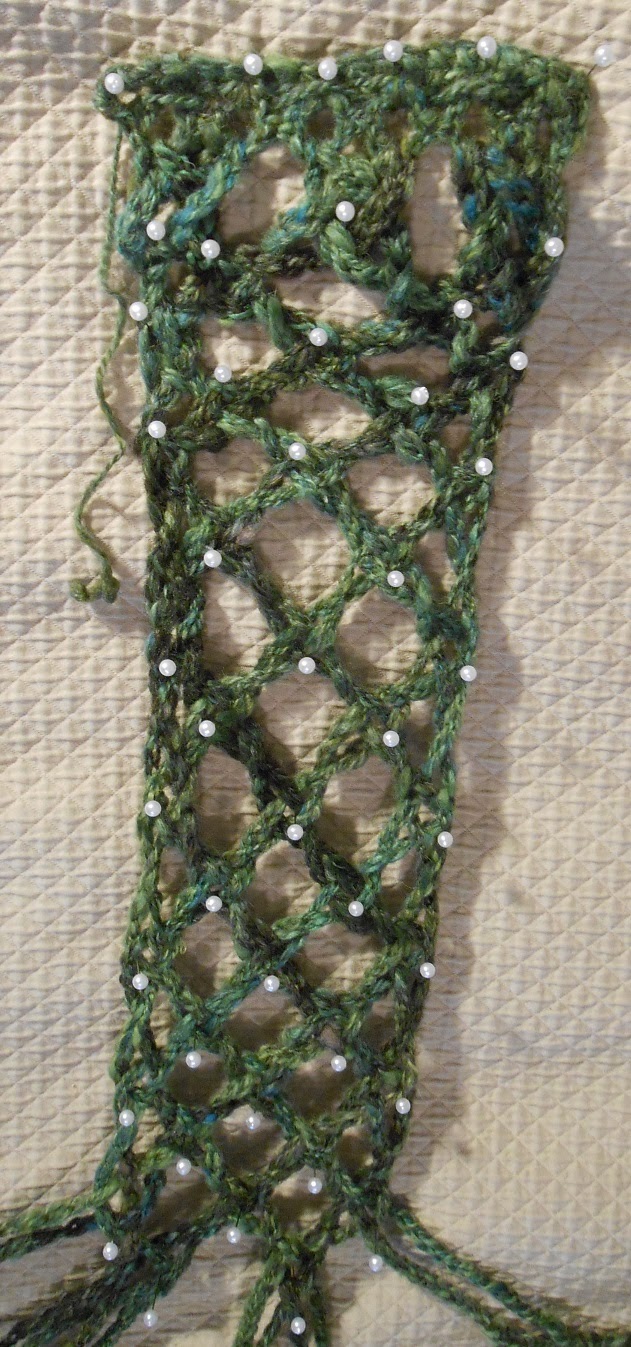A little over a year ago I got hold of a Spanish lace
magazine called, La Encajera. In it was a pattern
for a bobbin lace fan. It was really
beautiful but it was also composed of elements that I knew how to do –
individually, at least. The challenge
with it was that there were absolutely no instructions. There was the pricking and a good photo but
no clues as to how many pairs of bobbins, not to mention how to hang them,
start off or anything else. For a long
time, I knew it was beyond my skills so I prepared the pricking, ordered the
thread and waited for the right time.
It seems to be the right time now so I shrunk the pricking
to match the thread I wanted to use (a nice linen thread) and got everything
started. If I just work slowly and pay
close attention to how each element interacts with its neighbor, I should be
okay. I’ve only had to take out part of
it twice so I think this is pretty good progress.
The second project was one I thought about last summer as I
was in the process of buying the house.
I wanted something of my Glasgow heritage to be represented in the house
but wasn’t sure how I wanted to do it. After
I did the Victorian Lady piece for Jane, I realized that this was the perfect
style to work a piece based on the symbols and emblems that make up the coat of
arms of Glasgow.
All based on:
There’s the bird that never flew,
There’s the fish that never swam,
There’s the bell that never rang.
I’ve started but am prepared to go through a bit of trial
and error to make sure to get something that will take pride of place over the
mantle.
Finally, I had a crazy idea a couple of nights ago. I had brought up a handspun skein of yarn
from the basement that I was trying to decide what it wanted to be. I had a lot of fun spinning it but I only had
1 skein of chunky yarn that wasn’t super soft and I wasn’t sure what to do with
it. I’d brought it up and dug out some
needles, assuming I would be knitting something.
Who knows how these things happen but I looked at it and
thought, “I wonder if I could use this to lace a scarf?” Sure I could but how would I do it. Although it was pretty chunky, I felt it
needed a little more bulk so I decided to crochet a looooooong chain and use
that for the lacing. So I made a base
and then crocheted 6 pairs of chains. At
first I thought I would need more but after thinking about it a little, I
decided that any more would make it too bulky so I left it at that.
A couple of unknowns were:
-
How long should I make each chain? I just made them long and tried to make them roughly the same length. When I finished the chain, I only loosely bound it off – I figured I would need to adjust the length at the end of the day. Actually, I was pretty sure I would need to add to the length (I didn’t) but this would work either way – to lengthen or shorten.
- Where would I do the lacing? I wasn’t going to make an actual pricking so I thought the bed would be plenty long for working it. It was enough but not plenty. When I reached the end of the bed, I
finished. Plus I had only 1 of my large
pins left. It was long enough.
-
How would I finish it off at the end? I ended up making a similar placket to what I’d
begun with and tied the chains onto it.
The yarn ends were worked in with a needle but it needed more. I decided to go with a plaited fringe. I think it needs some large beads added to
the fringe area but I didn’t have what I wanted on hand and it’s a freezing
sheet of ice on the roads outside. Beads
can always be added later.
It was a fun project and gave me tons of ideas for some
funky projects I could work in a similar manner.








